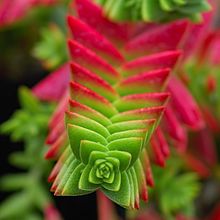Thick leaf
| Thick leaf | ||||||||||||
|---|---|---|---|---|---|---|---|---|---|---|---|---|

|
||||||||||||
| Systematics | ||||||||||||
|
||||||||||||
| Scientific name | ||||||||||||
| Crassula | ||||||||||||
| L. |

Thick leaf ( Crassula ) is the only genus of plants in the subfamily Crassuloideae within the thick leaf family (Crassulaceae). The botanical name of the genus is derived from the Latin adjective crassus for 'thick' and refers to the mostly succulent leaves. Its main distribution area is the Cape flora in southern Africa . Along with the genus Sedum, it is the most species-rich genus within the thick-leaf family (Crassulaceae).
description
Vegetative characteristics
The species of the genus Crassula are annual or perennial herbaceous plants, or dwarf to tree-shaped shrubs with heights of up to 2.5 meters. Rarely do they grow as tubers - geophytes . Their roots are fibrous to fleshy. The shoots are succulent and occasionally lignify. The cross-opposed leaves are thick and fleshy to membrane-like. The leaves of a pair are somewhat fused together at their base. They can be persistent or sloping, sitting or short-stalked. The leaves have entire margins and are divorced at their base. Their leaf blades can be bald, hairy, or warty. Occasionally they have clearly visible crevices .
Generative characteristics
The inflorescence is a thyrsus with single to numerous dichasias . Partial inflorescences are occasionally clustered in clusters. Inflorescences reduced to single flowers are rare . The bracts are often leaf-like. An inflorescence stalk may be present or it is indistinct. The bracts are then shorter or as long as the leaves.
The four to five-fold (rarely two to twelve-fold), mostly small flowers are haplostemon . The four to five (rarely two to twelve) sepals are briefly fused together at their base. The four to five (rarely two to twelve) petals are also briefly fused together at their base. There are often appendages at their tips. The stamens are fused with the petals at their base and alternate with them. The anthers can protrude from the flower. They do not have a terminal appendage. The nectar scales are flat to thick, the carpels are free or slightly sunk into the flower axis and gradually taper to a short or long stylus with individual scars .
The ellipsoidal seeds are smooth or warty, with the warts occasionally arranged in longitudinal rows.
distribution
The genus is almost exclusively found in Africa . It exhibits its greatest biodiversity in the Cape flora , which is home to around 150 species. Few species are found all over the world as swamp and aquatic plants. The only two species native to Germany, Crassula tillaea and Crassula aquatica , are now considered extinct there.
Systematics
The genus Crassula is the only genus in the subfamily of Crassuloideae within the family of thick-leaf plants (Crassulaceae). The first description was in 1753 in Species Plantarum by Carl von Linné . As a type plant of the genus was Crassula perfoliata L. determined.
Synonyms of the genus include Bulliarda DC. , Combesia A.Rich. , Danielia Lem. , Dinacria Haw. , Globulea Haw. , Gomara Adans. , Grammanthes DC. , Larochea Pers. , Rhopalota N.E.Br. , Rochea DC. , Sphaeritis Eckl. & Zeyh. , Tillaeastrum Britton and Vauanthes Haw.
According to Ernst Jacobus van Jaarsveld (* 1953) the genus Crassula is divided into two sub-genera with 20 sections and the following species:
|
Crassula subg. Disporocarpa fish. & CAMey.
|
Crassula subg. Crassula
|
The species Crassula cordifolia , Crassula micans and Crassula schmidtii are not clearly assigned . There is also the hybrid Crassula × justi-corderoyi .
proof
literature
- Ernst van Jaarsveld : Crassula . In: Urs Eggli (Hrsg.): Succulent lexicon. Crassulaceae (thick leaf family) . Eugen Ulmer, Stuttgart 2003, ISBN 3-8001-3998-7 , pp. 29-86.
Individual evidence
- ↑ Henning Haeupler , Thomas Muer: picture atlas of the fern and flowering plants of Germany (= The fern and flowering plants of Germany. Volume 2). Published by the Federal Agency for Nature Conservation. Ulmer, Stuttgart 2000, ISBN 3-8001-3364-4 .
- ↑ Species Plantarum . Volume 1, Lars Salvius, Stockholm 1753, p. 282 (online)
- ^ Ernst van Jaarsveld: Crassula . In: Urs Eggli (Hrsg.): Succulent lexicon. Crassulaceae (thick leaf family) . Eugen Ulmer, Stuttgart 2003, ISBN 3-8001-3998-7 , pp. 29-86.
Web links
- Entry at davesgarden.com (English)
